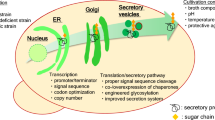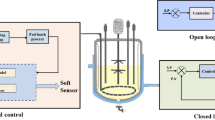Summary
This study highlights data about the production of a recombinant protein (glyceraldehyde-3-phosphate dehydrogenase) byE. coli HB 101 (GAPDH) during batch and fed-batch fermentations in a complex medium. From a small number of experiments, this strain has been characterized in terms of protein production performance and glucose and acetate influences on growth and recombinant protein production. The present results show that this strain is suitable for recombinant protein production, in fed-batch culture 55 g L−1 of biomass and 6 g L−1 of GAPDH are obtained. However this strain, and especially GAPDH overproduction is sensitive to glucose availability. During fermentations, maximum yields of GAPDH production have been obtained in batch experiments for glucose concentration of 10 g L−1, and in fed-batch experiments for glucose availability of 10 g h−1 (initial volume 1.5 L). The growth of the strain and GAPDH overproduction are also inhibited by acetate. Moreover acetate has been noted as an activator of its own formation.
Similar content being viewed by others
References
Boyer, H.W. and D. Roulland-Dussoix. 1969. A complementation analysis of the restriction modification of DNA inEscherichia coli. J. Mol. Biol. 41: 459–472.
Branlant, G., G. Flesh and C. Branlant. 1983. Molecular biology of glyceraldehyde-3-phosphate dehydrogenase genes ofBacillus stearothermophilus andEscherichia coli. Gene 25: 1–7.
Brown, S.W., H.-P. Meyer and A. Fiechter. 1985. Continuous production of human leukocyte interferon withEscherichia coli and continuous cell lysis in a two stages chemostat. Appl. Microbiol. Biotechnol. 23: 5–9.
Charpentier, B. and C. Branlant. 1994. TheEscherichia coli gapA gene is transcribed by the vegetative RNA polymerase holoenzyme Eσ p70 and the heat shock RNA polymerase Eσ p32. J. Bacteriol. Feb 1994: 380–389.
Curless, C.E., P.D. Forrer, M.B. Mann, D.M. Fenton and L.B. Tsai. 1989. Chemostat study of kinetics of human lymphokine synthesis in recombinantEscherichia coli. Biotechnol. Bioeng. 34: 415–421.
Doelle, H.W., K.N. Ewing and N.W. Hollywood. 1982. Regulation of bacterial metabolism in bacterial systems. Adv. Biochem. Eng. 23: 1–35.
El Houtaia, N., N. Nancib, G. Branlant, C. Branlant and J. Boudrant. 1989. Production of glyceraldehyde-3-phosphate dehydrogenase using genetically engineeredEscherichia coli. Biotechnol. Lett. 11: 775–778.
Ferdinand, W. 1964. Isolation and specific activity of rabbit muscle GAPDH. Biochem. J. 92: 1978–1985.
Fieschko, J. and T. Ritch. 1986. Production of human alpha consensus interferon to recombinantEscherichia coli. Chem. Eng. Commun. 45: 229–240.
Goldberg, A.L., K.H.S. Swamy, C.H. Chung and F.S. Larimore. 1981. Proteases inEscherichia coli. Methods Enzymol. 80: 680–702.
Han, K., H.C. Lim and J. Hong. 1992. Acetic acid formation inEscherichia coli fermentation. Biotechnol. Bioeng. 39: 663–671.
Ishikawa, Y., Y. Nonoyama and M. Shoda. 1981. Calorimetric analysis ofEscherichia coli in batch culture. Biotechnol. Bioeng. 23: 2825–2856.
Jung, G., P. Denèfle, J. Becquart and J.F. Mayaux. 1988. High cell density fermentation studies of recombinantEscherichia coli expressing human interleukin-1β. Ann. Inst. Pasteur/Microbiol. 139: 129–146.
Kapralek, F., P. Jecmen, J. Sedlacek, M. Fabry and S. Zadrajil. 1991. Fermentation conditions for high level expression of thetac promoter controlled calf prochymosin cDNA inE. coli HB 101. Biotechnol. Bioeng. 37: 71–79.
Koh, B.T., U. Nakashimida, M. Pfeiffer and M.G.S. Yap. 1992. Comparison of acetate inhibition on growth of host and recombinantE. coli K12 strains. Biotechnol. Lett. 14: 1115–1118.
Konstantinov, K., M. Kishimoto, T. Sato and T. Yoshida. 1990. A balanced DO-Stat and its application to the control of acetic acid excretion by recombinantEsherichia coli. Biotechnol. Bioeng. 36: 750–758.
Lischke, H.H., L. Brandes, X. Wu and K. Schügerl. 1993. Influence of acetate on the growth of recombinantEsherichia coli JM103 and product formation. Bioproc. Eng. 9: 155–157.
Miller, C.G. 1987. Protein degradation and proteolytic modification. In:Escherichia coli andSalmonella typhimurium: Cellular and Molecular Biology, Vol. 1 (Neidhardt, F.C., J.L. Ingraham, K.B. Low, B. Magasanik, M. Schaechter, H.E. Umbarger, eds), pp. 680–691, American Society for Microbiology, Washington, DC.
Mougin, A.C., C. Corbier, A. Soukri, A. Wonacott, C. Branlant and G. Branlant. 1988. Use of site directed mutagenesis to probe the role of cystein 149 in the formation of charge transfer transmission. Prot. Eng. 2: 45–48.
Nancib, N., C. Branlant and J. Boudrant. 1991. Metabolic roles of peptone and yeast extract culture of a recombinant strain ofEscherichia coli. J. Ind. Microbiol. 8: 165–170.
Nancib, N., R. Mosrati and J. Boudrant. 1993. Modelling of batch fermentation of a recombinantEscherichia coli producing glyceraldehyde-3-phosphate dehydrogenase on a complex selective medium. Chem. Eng. J. 52: B35-B48.
Pan, J.G., J.S. Rhee and J.M. Lebeault. 1987. Physiological constraints in increasing biomass concentration ofEscherichia coli in fed-batch culture. Biotechnol. Lett. 9: 89–94.
Peretti, S.W. and J.E. Bailey. 1987. Simultations of host-plasmid interactions inEscherichia coli: copy number, promoter strength, and ribosome binding site strength effects on metabolic activity and plasmid gene expression. Biotechnol. Bioeng. 29: 316–328.
Reiling, H.E., H. Laurila and A. Fiechter. 1985. Mass culture ofEscherichia coli: medium development for low and high density cultivation ofEscherichia coli B/r in minimal and complex medium. J. Biotechnol. 2: 191–206.
Shimizu, N., S. Fukuzono, K. Fujimori, N. Nishimura and Y. Odawara. 1988. Fed-batch culture of recombinantEscherichia coli with inhibitory substance concentration monitoring. J. Ferment. Technol. 66: 187–191.
Smirnova, G.V. and O.N. Oktyabr'skii. 1985. Influence of acetate on the growth ofEscherichia coli under aerobic and anaerobic conditions. Microbiology 54: 205–209.
Yee, L. and H.W. Blanch. 1992. Recombinant protein expression in high cell density fed-batch cultures ofEscherichia coli. Biotechnol. 10: 1550–1556.
Author information
Authors and Affiliations
Rights and permissions
About this article
Cite this article
Gschaedler, A., Thi Le, N. & Boudrant, J. Glucose and acetate influences on the behavior of the recombinant strainEscherichia coli HB 101 (GAPDH). Journal of Industrial Microbiology 13, 225–232 (1994). https://doi.org/10.1007/BF01569753
Received:
Accepted:
Issue Date:
DOI: https://doi.org/10.1007/BF01569753




